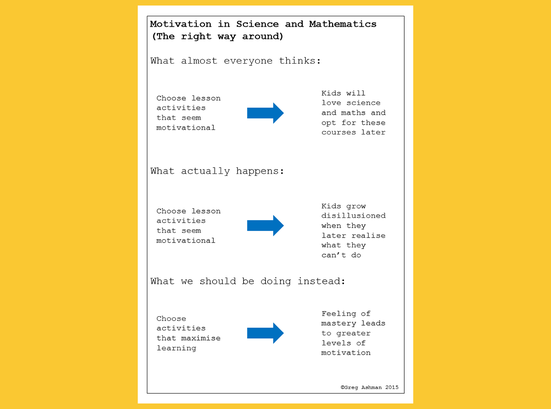Challenge misconceptions – ‘10 things every teacher educator should know’
Trainee teachers often start with many misconceptions about their subject, pupils and pedagogy.We explore how to counter these in our fifth '10 things' blog.
Trainee's misconceptions also often differ significantly between subjects and school phases. As this blog is aimed at teacher educators as a whole I will focus on myths relating to pedagogy, three in particular:
- Myth 1: “If you plan a well-differentiated lesson appropriate to children’s interests and needs, 90% of behaviour issues will be prevented.”
- Myth 2: “Get the kids motivated about the topic by making it exciting or relevant to them. If they’re motivated, they’ll work harder.”
- Myth 3: “Make sure your lessons cater for different learning styles; have a variety of auditory, visual and kinaesthetic activities.”
The last one in particular has become a zombie myth that simply will not die. As teacher educators, being aware of these types of myths is important – anticipating them and knowing how to overcome them will speed up trainees’ progress.
However, having the facts and arguments to disprove a myth is only part of the picture. You may encounter the ‘backfire effect’ – a psychological phenomenon that causes an incorrect belief to strengthen in a person’s mind when they’re presented with contradictory facts. One way to counter this is to ensure you have a theory or model ready to replace the incorrect belief. When challenging a trainee’s misconceptions, it’s hugely important to also provide guidance on what research evidence does tell us about topics such as behaviour, motivation and how pupils take in and process information.
The misconceptions and how to tackle them
Myth 1: “If you plan a well-differentiated lesson appropriate to children’s interests and needs, 90% of behaviour issues will be prevented.”
This is a particularly damaging misconception for trainees to have. Beginner teachers are likely to face behaviour issues in their lessons as children test the boundaries of their new teacher, and it happens at a time when a trainee’s ability to manage behaviour has yet to develop. Holding on to this myth can make trainees feel like poor behaviour is their fault. This leads to excessive planning, an unsustainable workload and, ultimately, challenges to wellbeing.
It’s important that teacher educators reassure trainees that this is a myth and explain why. It’s simply impossible to consider, plan for and prevent all possible instances of pupils choosing to go off-task, show defiance, or worse. Poor behaviour is almost never caused by the decisions a teacher makes, and so planning should focus on maximising pupils’ learning rather than minimising disruption.
Teacher educators can help trainees move beyond this misconception by showing them how to minimise disruption in lessons by proactively teaching desired behaviours, as well as how to respond, rather than react, to instances of poor behaviour. Having high expectations of all pupils, teaching routines for basic tasks (such as entering and exiting the room) and practising giving instructions will help to make sure pupils know what is expected of them. This will give trainees the time and mental space to make sure they can prioritise planning for important areas, such as managing pupils’ cognitive load, building pupils’ schemas and managing their knowledge retention in long-term memory.
Myth 2: “Get the kids motivated about the topic by making it exciting or relevant to them. If they’re motivated, they’ll work harder.”
This myth can be boiled down to the misleading idea that motivation leads to achievement. Getting pupils engaged in a topic through a fun activity, or by linking it to Fortnite or Love Island, is often thought to be good practice and the most desirable ‘way in’ to topics for pupils. Such strategies are supposed to overcome what is thought to be a lack of interest in unfamiliar or abstract topics, like finding four and six-figure grid references in geography, or calculating percentages in maths.
But this isn’t the case. Research in classrooms suggests that the relationship between motivation and achievement actually seems to run the opposite way, and that achievement leads to motivation. In other words, learning a lot about a topic or quickly developing a new skill creates a sense of achievement in the individual. This makes them more willing to continue to learn the subject. This relationship is summed up well by Greg Ashman :

This research shows that to generate genuine motivation in pupils, it’s best to organise activities that maximise learning. Relying on motivation generated by ‘fun’ or ‘relevant’ activities may have some initial ‘engagement’, but the effects will fade when the hard work of mastering abstract and unfamiliar concepts becomes a reality for pupils.
In light of this research, teacher educators should help their trainees develop their pedagogical content knowledge as much as possible. Increasing knowledge of the domain they are teaching should be the first priority for trainees. A good understanding of WHAT they are teaching can be combined with sources like Rosenshine and the Learning Scientists to find out HOW we can use effective pedagogy to prioritise pupil achievement. The informed selection of knowledge to be taught, its careful sequencing and a focus on embedding such content in pupils’ long-term memories will build intrinsic motivation.
Myth 3: “Make sure your lessons cater for different learning styles; have a variety of auditory, visual and kinaesthetic activities.”
This myth suggests information can be taken in, processed and learnt in three different ways: seeing (visual), listening (auditory) or doing (kinaesthetic) – also known as VAK, and that receiving information in their preferred way will lead to a person learning more effectively. Many trainees new to teaching in 2019 were taught this in schools – and they may have even taken learning style tests that sought to identify their preferred way of learning.
We now know this theory is, to be blunt, nonsense. Evidence suggests most people do have a preferred way of receiving information, either visually, aurally or kinaesthetically, but that this has no effect on the quality or quantity of learning, or on pupils’ achievement.
Of all three myths, the idea of VAK seems to be the one most susceptible to the backfire effect. So besides explaining evidence that debunks the theory, teacher educators need to have a credible alternative that will support trainees to design effective lesson activities.
That credible alternative is dual coding, which shows how information from the environment enters working memory (this may even have been the original source of the VAK myth). Working memory receives information through an auditory channel and a visual channel. Presenting information to pupils in class using both of these channels at the same time – combining verbal explanations with well-chosen visuals – reinforces and supports the processing of this information in working memory. Pupils are more likely to make sense of the information in the immediate term and retain it in the long term.
Case study: challenging misconceptions with trainees
These myths are linked by a common thread: they lead to poor practice, causing teachers to ignore best understandings of effective teaching. One group of trainees I worked with recently demonstrated the power of confronting them.
This group arrived in school at the start of the year with pupil behaviour and motivation at the forefront in their minds. They were worried they would have to plan to “meet pupils’ needs” by adapting resources and activities in multiple ways. They also wanted pupils to enjoy their lessons and be motivated to work hard, and wondered what activities they could design to do this.
This group was supported by an experienced team of in-school mentors who knew about the common learning myths and how to build pupil trust through clarity and consistency. They also knew creating 30 individual plans for every lesson and class was impractical. They knew that developing a culture of hard work and perseverance relies on pupils gradually developing a sense of competence and mastery, not spectacular PowerPoint slides and references to pupils’ favourite bands.
One way these expert mentors directed trainee efforts productively was through standardised routines at the beginning of lessons:
- An emphasis on always being at the door to welcome pupils and direct them to their places
- Pupils to stand behind their chairs in silence until invited to sit down in silence
- The first lesson activity always consisted of retrieval practice – pupils answering five questions from memory on recent topics, as well as topics from the previous unit of study and previous terms.
This routine created a calm and focused environment at the start of lessons. It added predictability, which minimised off-task behaviour as pupils were clear what was expected of them. The regular use of retrieval practice, with questions carefully chosen to emphasise key subject content, cemented this knowledge in pupils’ long-term memories. Over time, this created a sense of competence in pupils – the kind of confidence that leads to genuine motivation.
About the author
Lee is a teacher educator working for Teach First in the East Midlands. He's also a Teach First Ambassador, who joined our programme to train as a teacher in 2004. Find him on Twitter @LeeDonaghy
About this series
We train thousands of new teachers each year, but this is only around 5% of all new teachers. So we wanted to share some of the thinking behind our teacher education in this series of blogs. We hope these blogs will be helpful for the thousands of schools that support new trainee teachers each year, and act as a starting point for conversations with other teacher educators – so we can all keep learning and improving.
This is our current thinking but we’re always reviewing and learning from research, other organisations and practice. We want your views and feedback: What do you agree with? Is there anything you disagree with? What have we missed? Let us know on twitter – you can chat to our teacher education leads @FayeCraster and @Reuben_Moore (and we’re on @TeachFirst)
